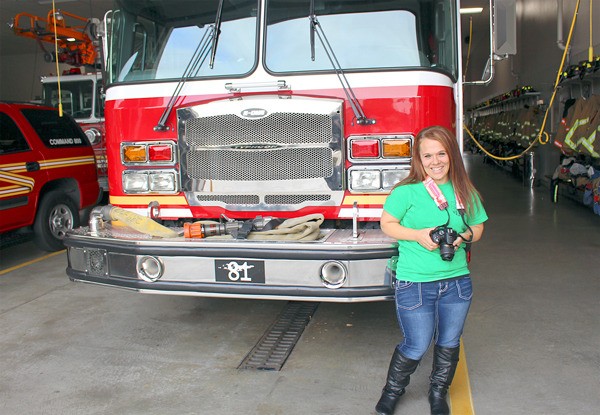As a young girl, Lolly Titherington knew a few things about herself.
She knew that, when she grew up, she wanted to race to the scene of a crash to help. She knew she had a wicked sense of humor and an artistic streak.
She also knew that she was smaller, and that she looked different from most other people.
Kids teased. Teachers assumed her condition indicated a dull intellect.
It doesn’t.
People underestimated her.
“There was a lot of judging,” she said.
At age 34, Titherington is a member of the Oak Harbor Fire Department. She serves as the department’s photographer, hopping onto a rig with firefighters to zoom to fires and crashes.
Soon she’ll assume the role of public information officer.
“SHE IS a very caring person,” said Chief Ray Merrill. “She brings a lot of ‘let’s get in and get it done’ to the job.”
Growing up in South Whidbey, Titherington didn’t see anyone on the island with her condition: hypochondroplasia, a form of dwarfism.
At times her childhood was hell.
It wasn’t just feeling different or enduring stares or negotiating a world built for taller people. It was physically painful — and continues to be.
As a child, some parts of her body grew at a different rate than others. By the time she entered high school, her legs were so bowed she couldn’t walk. In 1996, she was one of the first to have what was then experimental surgery at Seattle Children’s Hospital to straighten her legs. It took her a year to recover but it worked.
She also had surgery to correct her hands and her jaw.
After high school, she hadn’t given up on her dream of working as a first responder. After a year spent nannying, she trained to become an emergency medical technician.
WHEN IT came time to apply for a job, she had to fight against other people’s perceptions of what she could do.
“It was hard just to get in,” she said. “I was already being judged. I had to prove myself.”
She met all the physical requirements for the job, including meeting the time standard in the mile run, completing agility tests and carrying a full-weight Rescue Randy dummy.
She was hired and worked eight years for fire and rescue departments on the island as an EMT.
Titherington excelled at the job. Stressful situations and sometimes gruesome crash scenes don’t easily faze her. But there were difficult moments. An infant she held in her arms who didn’t make it. An accident that killed a man at the Island County Fair.
In that instance, in 2003, one of the co-owners of the carnival became entangled in a ride while trying to repair it. It hit her hardest because children saw what happened.
MANY PEOPLE with dwarfism suffer from neck and back problems, and Titherington is no exception. Spinal stenosis, a narrowing of her spine, leaves her arms numb sometimes.
The discs in her back are also herniated and bulging.
With time, the pain in her back became so overwhelming, she wasn’t able to do her job.
At first, she didn’t want to acknowledge it, didn’t want to give up her life’s work. Eventually, the pain became too much. In 2009, she left her job as an EMT. For a time deep depression swallowed her.
“I felt I wasn’t worthy anymore,” she said. “What was I going to do? I didn’t have anything to wake up and look forward to.”
The volunteer job at the Oak Harbor Fire Department was a life changer, she said. She started there in 2012. She now wakes up with a purpose. It keeps her mind sharp. Her colleagues say she’s one of the team.

“SHE IS a consummate professional who strives to obtain any standard placed in front of her,” said Capt. Craig Anderson.
Titherington is working on a project with the department, photographing all the city’s schools so the fire department can build sand table models to better prepare for emergencies, he said.
In addition to photographing for the department, she’s training to serve as a public information officer, which will put her front and center with the media and the community.
She continues to work through sometimes debilitating back pain.
No one at the department views Titherington as different, said firefighter Genevieve Cox.
“Lolly is part of the team just like anyone else,” she said. “She helps promote a greater community awareness, brings in another perspective and fresh ideas. Without her, OHFD would not be the organization it is today.”
OCTOBER IS National Dwarfism Awareness Month and, in support of Titherington, the department is donning green shirts. Titherington has a few things she wants you to know.
Reality shows such as TLC’s “Little People, Big World,” have helped to educate a segment of the public and provide more positive depictions of little people than in the past.
But not everybody watches those shows.
Even as an adult, people do things that range from misguided helpfulness to downright rude. People pat her on the head and try to pick her up. Strangers snap photos. Sometimes she’s talked to like a child. Children make comments and parents quickly hustle them away.
“Sometimes I walk away from it and sometimes I lose my filter,” she said.
Then there’s the “m” word — midget. It’s an offensive slur. The term originates from the mid-1800s, when it was used to describe short-statured people who were put on display for public amusement.
Little People of America, an international support organization, advises instead using “dwarfs, little people, people of short stature or having dwarfism, or simply, and most preferably, by their given name.”
IF TITHERINGTON needs help — and she usually doesn’t — she asks for it.
And parents, she said, it’s OK to answer kids’ questions and to talk with her directly.
She understands kids are kids.
She wants to be treated and talked to like everybody else.
“There is no little person, there’s just Lolly.”



